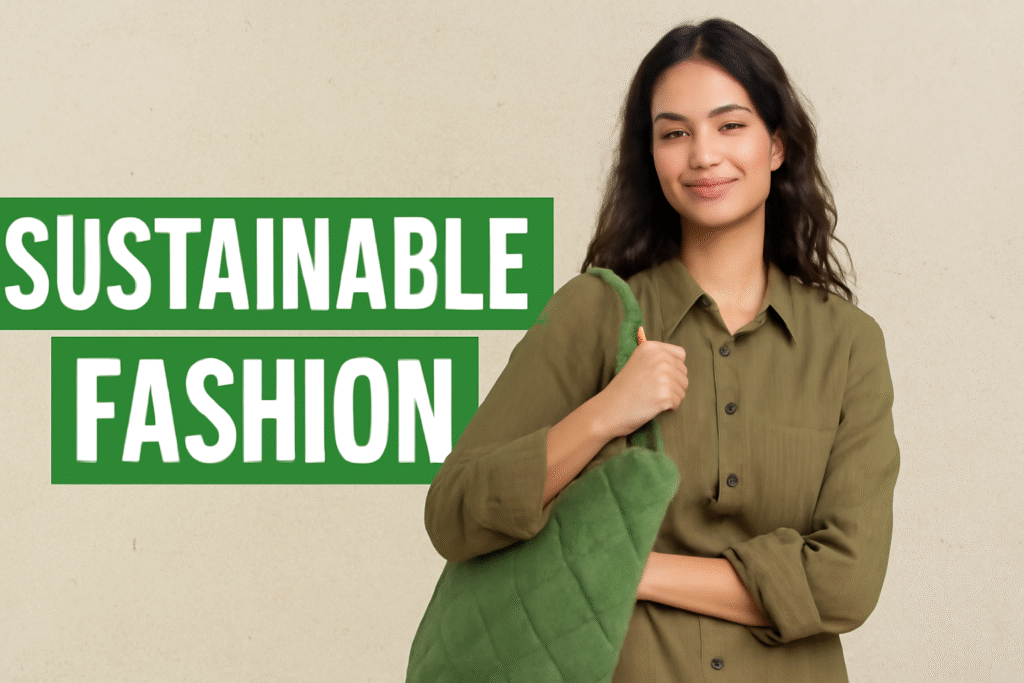Introduction
Sustainable fashion has rapidly emerged as a powerful movement, pushing the fashion industry to rethink its practices, challenge the status quo, and embrace environmental and ethical responsibility. As consumers become more aware of the environmental and social impact of their choices, the demand for eco-friendly, ethical fashion brands has surged. This shift has led to the rise of companies focusing on sustainability, adopting eco-friendly materials, and even rethinking how clothes are designed and consumed.
In this article, we will explore the concept of sustainable fashion, its importance, the trends shaping it, and how both consumers and the industry are embracing a more ethical and sustainable future.

What is Sustainable Fashion?
Sustainable fashion refers to the practice of designing, producing, and consuming clothing in ways that are environmentally friendly and socially responsible. Unlike fast fashion, which focuses on mass production of cheap, disposable garments, sustainable fashion encourages slower production cycles, high-quality materials, and ethical working conditions.
The principles of sustainable fashion encompass several key elements:
Environmental sustainability: Reducing the fashion industry’s carbon footprint, minimizing waste, and using eco-friendly materials.
Social sustainability: Fair wages, safe working conditions, and ensuring that workers are treated ethically throughout the production process.
Economic sustainability: Supporting fair trade practices, contributing to local economies, and encouraging longevity in fashion items.
By supporting sustainable fashion, both brands and consumers aim to lessen the industry’s negative environmental and social impact while promoting the longevity of fashion products.
Why Sustainable Fashion Matters
Environmental Impact of Fast Fashion
The environmental impact of the fashion industry is staggering. It is responsible for 10% of global carbon emissions, and the production of textiles contributes heavily to pollution. The industry uses vast amounts of water and toxic chemicals in manufacturing processes, leading to polluted waterways and landfills filled with discarded garments.
Fast fashion exacerbates this issue by promoting mass production and consumption of low-cost clothing, which is often worn only a few times before being discarded. This cycle leads to excessive waste, contributing to environmental degradation on an unprecedented scale.
Ethical Issues in Fashion
Beyond the environment, fast fashion also raises ethical concerns. The global supply chain often involves exploitative labor practices, with workers in developing countries being paid minimal wages and working in unsafe conditions. Brands in the fast fashion industry may turn a blind eye to these issues in favor of low production costs and maximizing profits.
Sustainable fashion aims to address these ethical concerns by promoting fair wages, ethical sourcing of materials, and safe working conditions for garment workers.

Key Trends in Sustainable Fashion
Sustainable fashion isn’t just about recycling clothes – it’s an entire ecosystem of change that includes new approaches to production, design, and consumption.
Eco-Friendly Fabrics
One of the most significant trends in sustainable fashion is the use of eco-friendly fabrics. Materials like organic cotton, hemp, bamboo, and Tencel are being used as alternatives to conventional fabrics. These fabrics are grown and processed with less water, fewer pesticides, and fewer harmful chemicals, making them more sustainable than their traditional counterparts.
Recycled materials are also making their way into fashion. Recycled polyester, for example, is made from post-consumer plastic bottles and offers a sustainable alternative to virgin polyester.
For more information on sustainable fabrics, check out resources like Good On You (goodonyou.eco) and Sustainable Jungle (sustainablejungle.com).
Circular Fashion and Upcycling
Circular fashion refers to a closed-loop production model where products are designed for reuse, recycling, and longevity. Brands are embracing circularity by creating garments that are built to last longer, can be easily repaired, and can be recycled at the end of their life cycle.
Upcycling, or repurposing old garments into new designs, is also a growing trend in sustainable fashion. By giving old clothes new life, consumers can reduce waste and extend the lifecycle of their wardrobe items.
Learn more about circular fashion from The Sustainable Fashion Forum (thesustainablefashionforum.com) and Circle Economy (circle-economy.com).
Slow Fashion vs. Fast Fashion
Slow fashion is a direct response to the rapid pace of fast fashion. It emphasizes high-quality production, thoughtful consumption, and a focus on durability. Slow fashion advocates for buying fewer, but better, pieces that are timeless, versatile, and made to last. In contrast, fast fashion encourages constant buying and disposal of low-cost, trend-based items.

How Sustainable Fashion Is Changing the Industry
The fashion industry is starting to see significant changes thanks to the rise of sustainable fashion. Brands are rethinking how they produce and market their products, and consumers are demanding more transparency and responsibility from companies.
The Role of Eco-Friendly Brands
Eco-friendly brands are leading the charge in sustainable fashion. Companies like Patagonia, Stella McCartney, and Reformation are pioneers in promoting sustainability through ethical sourcing, eco-friendly materials, and transparent supply chains. These brands are proving that it’s possible to create beautiful, fashionable items without harming the planet or exploiting workers.
Explore top sustainable fashion brands on Harper’s Bazaar (harpersbazaar.com) and Marie Claire UK (marieclaire.co.uk).
Consumer Demand for Sustainability
Consumers are increasingly choosing brands that prioritize sustainability. According to a 2020 study by McKinsey, 67% of consumers consider sustainability when making purchasing decisions. This shift is forcing companies to adapt, and many are incorporating sustainable practices into their business models to meet the growing demand for eco-friendly fashion.
Challenges Facing the Sustainable Fashion Industry
Despite the positive momentum, sustainable fashion faces several challenges.
Cost and Accessibility
Sustainable fashion is often more expensive than fast fashion. The use of high-quality, eco-friendly materials and fair labor practices can drive up production costs, which are passed on to consumers. For many people, the higher cost of sustainable clothing can be a barrier to entry.
Lack of Transparency
While some brands are genuinely committed to sustainability, others may engage in “greenwashing” – making exaggerated claims about their sustainability efforts without backing them up with concrete actions. Consumers often find it difficult to determine which brands are truly sustainable and which are just jumping on the trend.

What Consumers Can Do to Embrace Sustainable Fashion
As consumers, we hold the power to drive change. Here are some ways we can embrace sustainable fashion:
Make Informed Choices: Research the brands you buy from and ensure they align with your values. Look for certifications like Fair Trade, GOTS (Global Organic Textile Standard), or B Corp, which signify ethical and environmental responsibility.
Support Eco-Friendly Brands: Choose to invest in brands that prioritize sustainability, even if they are more expensive. These purchases help support a more sustainable industry.
Buy Less, Choose Wisely: Embrace the slow fashion movement by purchasing high-quality, timeless pieces that will last for years.
The Future of Sustainable Fashion
The future of sustainable fashion is bright. With technological innovations, consumer demand for eco-friendly products, and a growing awareness of the fashion industry’s impact on the planet, we are likely to see even more sustainable practices emerge. From biodegradable fabrics to new recycling technologies, the future of fashion is increasingly circular, transparent, and environmentally conscious.
Conclusion
Sustainable fashion is more than just a trend – it’s a movement that is reshaping the fashion industry. By choosing eco-friendly materials, embracing ethical labor practices, and supporting brands that prioritize sustainability, consumers can contribute to a healthier planet and a more ethical world. The rise of sustainable fashion proves that it is possible to marry style with responsibility, and as the industry continues to evolve, so too will the choices we make as consumers.


